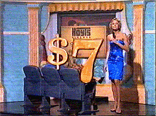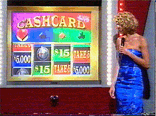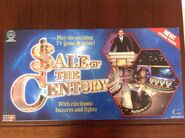| Hosts | |
| Tony Barber (1980-1991) Glenn Ridge (1991-2001) | |
| Co-Hosts | |
| Victoria Nicholls (1980-1982) Delevene Delaney (1982-1985) Alyce Platt (1986-1991) Jo Bailey (1991-1993) Nicky Buckley (1994-1999) Karina Brown (2000-2001) | |
| Announcers | |
| Ron Neate (1980) Pete Smith (1980-2001) | |
| Broadcast | |
| Nine Network: 14 July 1980-29 November 2001 | |
| Packager | |
| Grundy Organization | |
Sale of the Century (also briefly known as Sale of the New Century) is the classic and long-running quiz show based on a U.S. format of the same name where it mixed with shopping and bargaining, while contestants answered questions and bought prizes at a low cost.
The show started out as Great Temptation. When it was revived in 2005, it was renamed simply Temptation.
Main Game
All contestants were spotted with $20 to start. The host read a trivia question to the three contestants (one of which was usually the winner of the previous show). The first to press a buzzer would get an opportunity to answer the question (even if the host was still in the middle of reading the question). Players' scores increased by $5 for each correct answer and decreased by $5 for each incorrect answer. If a player answered incorrectly, the correct answer was revealed and the game would go on to the next question - that is, only one person could try to answer each question.
Gift Shop
Once per round, the highest-scoring player would get to go to a "gift shop" and was offered the chance to sacrifice some part of his/her score to "purchase" a prize. The prizes, and the cost, increased in each round. Contestants were allowed to haggle with the host, who, depending on the game situation, could reduce the cost and offer inducements including actual cash in order to entice the contestant to purchase. If two or more players had the same score at this point, a Dutch auction was conducted for the prize whereby the host would incrementally reduce the selling price until either contestant buzzed in or the host decided not to lower the prize any further and announced "no sale".
Some gift shops also included a bonus prize called a "Sale Surprise", revealed only after the conclusion of the gift shop (whether the contestant bought the prize or not).
Cash Box/CashCard
In 1986, the third Gift Shop prize was replaced by these two mini-games, giving players an opportunity to win some cash, an extra prize, or earn extra score money:
Cash Box
The player in the lead (auction if there was a tie) would be given the opportunity to play for a cash jackpot, which started at $2,000 and increased by $1,000 every day until it was won. To play, he/she would have to give up his/her lead over the second-place competitor. If the contestant opted to play, he/she selected one of three boxes. One box contained the jackpot while each of the other boxes contained cash prizes of $100 and $200.
This mini-game was later adopted in the American version as "Instant Cash".
Cashcard
In 1989, the Cash Box was replaced with "Cashcard," an opportunity for the leading contestant to either win a cash prize equivalent to perhaps a month's average wages for a middle-class Australian at the time, earn the opportunity to win a car later in the game (see section on major prizes), receive the score they sacrificed back, or reduce the score of a competitor slightly. This cost a player $15 to play.
Four playing cards (the Aces of each suit) were presented; the player selected one, and it was turned over to reveal one of four elements:
- $15 – Gave the player the money back.
- Joker – worth a "booby prize"; essentially a worthless card.
- Prize – A bonus prize, usually worth between $2,000 and $3,000.
- Cash Card – A growing jackpot that began at $5,000 and increased by $1,000 for each night it wasn't won.
For the first three years of this format, if the leading player opted not to go for the Cashcard, the second-place player was then offered that chance, but the jackpot card was removed from the lineup. In the event of a tie-breaker between the second- and third-place contestants, a general knowledge question was asked, and the first person with the correct answer played. This option was discontinued after 1992.
In 1993, two significant changes were made to the Cash Card: The Cash Card itself froze at $5,000, but occasionally was worth $10,000; and the "Joker" was replaced with the "Take $5" card, which allowed the player to remove $5 from one of their opponents' scores.
A year later, keeping with the "casino" theme, the playing cards were replaced with four single-reeled slot machines (referred to in Australia as "poker machines" or "pokies"). Each one was rigged to land on one element, and when the player selected a suit, the co-host pulled the handle to reveal the outcome. In addition, the "Take $5" was relegated to celebrity specials, and replaced on the regular shows with a machine displaying the logo of the car on offer that week. If the player selected this machine and eventually won the game, the car would be placed on the Winner's Board (see below).
For the 1997 "Family Challenge" tournament, the Cashcard segment was replaced by a revamped "Cash Box" segment. Four numbered boxes were presented, offering the same results as per tournament Cashcard rounds (either $5,000 cash, the prize on offer, $15 back on to the score, or "Take 5").
In 2000, as part of the show's revamp, the slot machines were replaced by a video screen, again showing fixed outcomes for each suit. The only prize on offer was the $5,000 cash, along with "Take 5", "$15" back on to the score, or the "Car". Unlike previous Cash Card incarnations, all results were shown on the screen at the same time, including the outcome that the contestant received.
During the 21st Birthday special and other celebrity specials, the "Car" was replaced by the "Bonus Spin", entitling the contestant to an additional chance at winning money.
Fame Game
A longer-format question generally known as the "Who am I?" question was asked once in each of the three rounds. Here, a succession of increasingly larger clues were given to the identity of a famous person, place, or event. In this round, players could buzz in and answer at any time, without penalty for an incorrect answer. However, each player only had one chance to answer. If one of the players buzzed-in and answered correctly, he/she had an opportunity to play the "famous faces" sub-game, where he/she got to choose randomly from a game board with nine squares featuring the faces of celebrities, mostly performers on the network's shows. Once chosen, the face selected would be spun around to reveal either a relatively small prize (typically appliances or furniture valued at around a weekly wage) or a $25 money card, which awarded $25 to the player's score.
By 1084, additional $10 and $15 money cards were added to the gameboard, with the $10 available at the outset, the $15 added at the second "Who am I" and the $25 at the third. Also added in the final "Who am I" was a "wild card," which offered the choice of $1,000 in cash or a chance to pick again. From 1989 to 1993, a fourth game was added with $20 card added in the third Fame Game and the $25 card added in the fourth. The $20 card (and therefore the fourth Fame Game) was removed in 1993.
Fast Money/Mad Minute
Originally, after the third Fame Game, three more general knowledge questions were asked, and the contestant with the highest score was the winner. (On the first episode, there was only one question following the last Fame Game question.) Around 1983, this was replaced with a speed round called "Fast Money" where the host would ask the questions in a particularly rapid-fire manner, attempting to fit in as many questions as possible in a 60 second time limit. Starting in 1989, there was a shorter 30-second fast money section in round two before the Gift Shop, Thus, the original speed round was reduced to 30-seconds; however, it was later restored to a minute, and renamed The "Mad Minute". Most of the more successful players proved themselves particularly adept at this section.
On 12 November 1986, part-time taxi driver David Poltorak achieved the highest front game score on the Australian version, $200, and consequently won the total endgame prize pool on offer (totalling a then-record $376,104). As far as a front game score, a close second may belong to a man named Ian, who in 1985 won a game with a score of $170.[1] Virginia Noel, who won a game in 1983 with a score of $155 while not letting her opponents answer any questions during Fast Money may hold third.[2]
The winner of the game was the person with the most money at the end. If there was a final tie, the tied players answered a tiebreaker "Who am I" question, where a correct answer from either contestant won the game, while an incorrect answer defeated the contestant in favor of his or her opponent.
Sale of the New Century
In a bid to combat declining ratings, the show was renamed Sale of the New Century in 2000. The format was also altered slightly to include four contestants per night in an elimination format; the lowest-scoring player would leave after the first fast money round, and another just before the final fast money round.
In addition, a lengthy question, called a 'brain drain', is introduced. Contestants could score $5, $10, $15 or $20, depending on how early they could give the correct answer.
The Cash Card changed to a large touch-screen monitor; the co-host touched a suit, then hit a button to spin the "reels". In addition, the "Prize" was replaced with "Take $5".
Also, contestants who won "all the way", would then compete in a "best of three" play-off entitled "Super Sale." The first two contestants to win since the format change played against each other to win the same amount of cash as the latter contestant's cash jackpot. After this, the "reigning champ" would play against the next Grand Champion to win "all the way" for a cash amount equal to their jackpot prize.
The "New" was dropped from the title in 2001, and the show returned to a three contestant format, but continued to eliminate the low scorer before the final fast money.
Bonus Games
The show went through two bonus games during its 21-year run:
Shopping format
A series of six prizes was offered, culminating in one or sometimes two luxury cars. A contestant could take his or her cumulative winnings, buy a prize, and retire, or elect to return the next day and try to win enough to buy the next most expensive prize. Any champion who earned enough cash to buy the car could leave with the car or return the following night to play for all six prizes.
Starting in 1982, once the player had banked $620, he or she could take home a large cash jackpot, which started at $50,000 and increased at a rate of $2,000 per night until somebody won it, or return for one more night and try to win all of the prizes (which totaled over $100,000) plus the jackpot. In later shows, they could purchase all of the prizes for $605 and all of the prizes plus the cash jackpot (the "lot") for $700. The largest jackpot ever won was $508,000.
Winner's Board
In 1989 (as part of the aforementioned format revamp) the producers did away with the shopping format. Instead, the contestant would face a 12-space board. The Winner's Board contained six prizes on 12 cards — five pairs of matching cards, one "Car" card, and one "Win" card (if picked, the next number selected resulted in an automatic match). The contestant called off numbers and the first prize matched was the first prize won, but in order to win the car, the player had to select the win card first before selecting the number that had the car card. In 1993, the car and win cards were replaced by another prize; as mentioned above, picking the "car space" in the Cashcard (or have a winning score of over $100) allowed the car and win cards to be placed. If a champion cleared the board, but didn't do either the aforementioned tasks, their next game was for the car.
After the player made a match, he/she faced a decision: either leave with all the prizes earned off the board, or risk them and play another show. A loss cost the player all his or her prizes from the board, while clearing the board and winning one more game (which took seven (later eight) days to do it) earned them the cash jackpot.
Tournaments
In 1985, the Australian/American challenge aired featuring the biggest winners from the Australian version competing against the biggest winners from the American version for $100,000. The first week consisted of 12 Australian champions playing against each other, three at a time, where the four winners of each heat compete on the Friday show to determine the two representatives for that country. The same was done during the second week with 12 American champions. The third week was a "best of 5" playoff where the first team that won three games won $100,000. The Australian team (consisting of Virginia Noel and Fran Powell) beat the American team (consisting of Frances Wolfe and Alice Conkright) winning three straight games.
In 1986, the Ashes series aired which followed the same format as the previous year's Australian/American challenge but featuring the biggest winners from the Australian version competing against the biggest winners from the British version again for $100,000. Again, the Australian team (consisting of David Bock and Cary Young) beat the British team (consisting of Daphne Fowler and Susan Kaye) also winning three straight games.
Later that year, the Commonwealth Games aired featuring contestants from Australia, Canada, and New Zealand competing against each other. This tournament was won by Cary Young.
In 1987, 1988, and 1989, three World Championship series aired featuring champions from the Australian, New Zealand, American, and British versions competing against each other. Cary Young won the 1987 series, David Bock won the 1988 series, and Brian MacDonnell won the 1989 series.
In 1987, 1988 and 1989, three Student Championship series aired featuring Year 12 students from across Australia competing against each other.
In 1990, Young, Bock, and MacDonnell competed against each other in the Masters series, which was won by Young.
Celebrity Weeks
Starting in 1990, occasional weeks were set aside for celebrities to play the game. Each week consisted of sixteen celebrities playing over four days. The four winners from those shows met in a two-day final, in which the celebrity with the highest score over those two days won the competition. The first one was to mark their 10th Birthday in 1990
Each celebrity played for a home viewer, who won all cash and prizes earned during the show. The ultimate winner's home viewer also won an extra prize, usually a car.
Top 10 Grand Champions
| Rank | Name | Amount Won | Year |
|---|---|---|---|
| 1 | Robert Kusmierski | $676,790 | 1992 |
| 2 | Kate Buckingham | $471,640 | 1990 |
| 3 | Simon Fallon | $434,065 | 2001 |
| 4 | Sandra Oxley | $421,080 | 1997 |
| 5 | Tom Beck | $420,573 | 2000 |
| 6 | Richard Hitesman | $382,341 | 1993 |
| 7 | David Poltorak | $376,104 | 1986 |
| 8 | Peter McMillan | $372,538 | |
| 9 | Cameron Burge | $360,844 | 1995 |
| 10 | Andrew Yeend | $357,889 | 1999 |
Other notable wins include:
- Vincent Smith of Sale, Victoria, the first champion to win the lot (before the cash jackpot) with $73,099. In 1985, he would author The Great Australian Trivia Quiz Book.
- Cary Young, who won $78,606 in 1982 and went on to win the 1987 World Championship (among several other tournaments).[3]
- Hayward Mayberley, who won $343,536 in cash and prizes (including a $206,000 cash jackpot, then marked as a world record) in 1983.[4]
Videos
Merchandise
Board Games
Various board games based on the show have been made and released by Crown & Andrews.
PC CD-ROM Game
A PC CD-ROM Game featuring former host Glenn Ridge and Nicky Buckley on the cover was released somewhere in the 90s at the time.
Music
- Main theme composed by Jack Grimsley
- 1986-1988 version arranged by Alan Deak
- Incidental music (1989 onwards) composed by Tweed Harris
Additional Pages
Spin-Off/Revival
References
Links
The Aussie Sale Page
Memories of Sale of the Century Australia & New Zealand Facebook Page
Sale of the Century @ Pearson Television's official website (via Internet Archive)
Sale of the Century programme description @ Fremantle's Old Website (via Internet Archive)


























